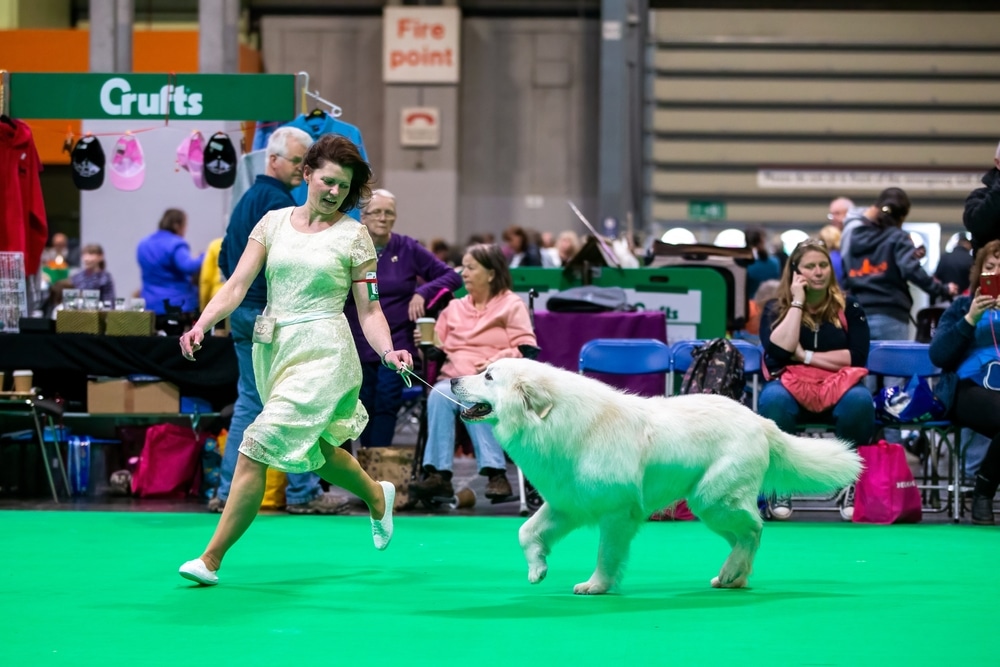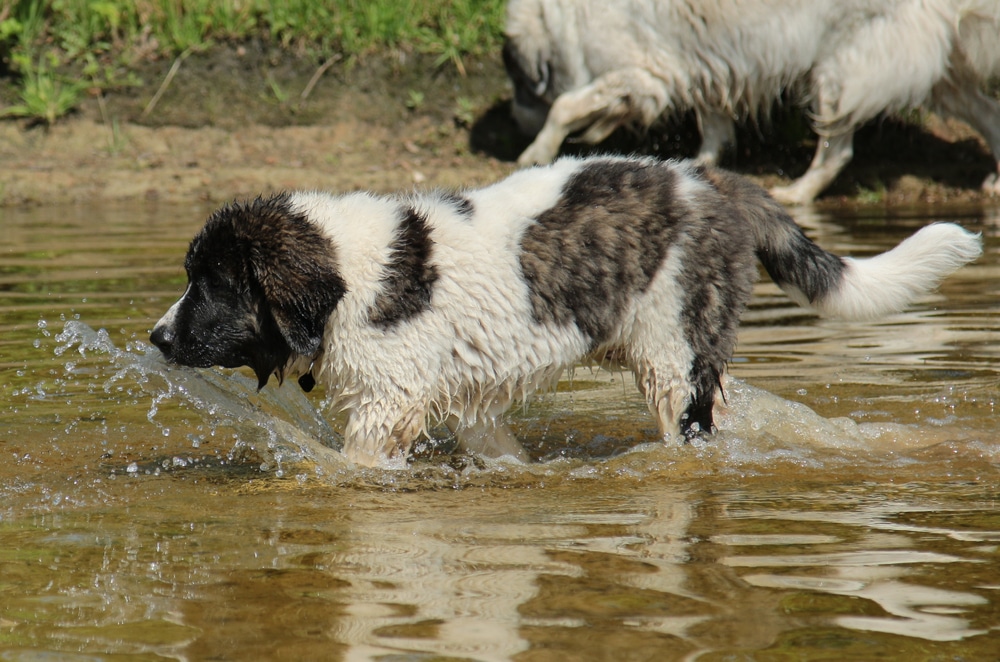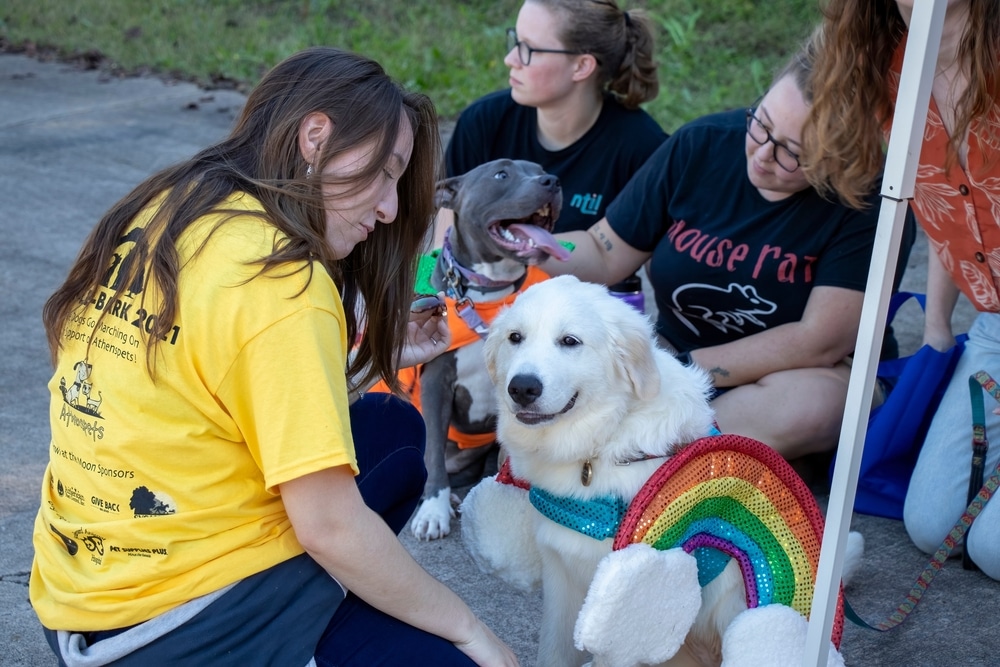Do you love big, fluffy dogs? If so, you may be wondering whether a Pyrenean Mastiff or a Great Pyrenees is the right breed for you. Both breeds are gentle giants with a lot of love to give.
However, there are some essential differences between them that you should consider before making your decision.
We look at their differences in temperament, trainability, exercise needs, and aggression levels.
We also explore their compatibility with other dogs and children, as well as health conditions to be aware of and their typical life expectancy. Read on to find out more!
Breeding History
The Pyrenean Mastiff and Great Pyrenees breeds are often confused with one another. Though they share similar features, there are some critical differences between the two.
People developed the Pyrenean Mastiff in the 1970s in an effort to recreate the ancient Molosser-type dogs of the Pyrenees Mountains.
On the other hand, the Great Pyrenees has a long and rich history dating back to 1675, when it was first mentioned in French literature.
Though both breeds were used for guarding livestock in their native mountain regions, the Pyrenean Mastiff was explicitly bred for fighting, while the Great Pyrenees was bred more for its gentle temperament and calm demeanor.
As a result, the Pyrenean Mastiff is typically more aggressive and territorial than its cousin.
Do they Look Similar?
Are you looking at a Great Pyrenees or a Pyrenean Mastiff and wondering if they are different breeds or just look similar?
While both dogs are large, fluffy, and have thick coats of fur, there are some subtle differences in their appearance.
The most obvious difference is size. The Great Pyrenees is the smaller dog of the two, weighing 100 pounds for males and 85 pounds for females. The Pyrenean Mastiff is larger, with males weighing 140-180 lbs and females 130-170 lbs.
Another difference is in their head shape. The Great Pyrenees has a more rounded head, while the Pyrenean Mastiff has a longer, squarer head. And finally, the color of their fur can be different too.
The Great Pyrenees has longer hair around their ears, while the Pyrenean Mastiff has shorter hair.
Pyrenean Mastiff vs Great Pyrenees – Aggression Levels
Generally speaking, the Pyrenean Mastiff is a more aggressive breed than the Great Pyrenees. This is not to say that all Pyrenean Mastiffs are fierce, but it is more common for this breed to show aggression than the Great Pyrenees.
There are several reasons why this may be the case, including the fact that the Pyrenean Mastiff was initially bred as a guard dog, whereas the Great Pyrenees was originally bred as a livestock guardian dog.
Of course, aggression levels can vary significantly from individual to individual within any dog breed.
“As a result of their similar genetic roots and the fact that both breeds were used for similar purposes, many owners of Great Pyrenees and Pyrenean Mastiffs will cross these two breeds in an effort to produce a perfect livestock guardian dog”.
Pyrenean Mastiff vs Great Pyrenees – Overall Strength
The Pyrenean Mastiff is a large, muscular dog that was originally bred to be a working dog. The Great Pyrenees is a larger, more docile version of the same breed.
Both dogs are known for their strength, but the Pyrenean Mastiff is generally considered to be the stronger of the two.
Bite Strength
When it comes to bite strength, the Pyrenean Mastiff and Great Pyrenees are in a class of their own.
Both breeds have powerful jaws that can exert a tremendous amount of force, making them capable of causing serious damage to their prey.
The Pyrenean Mastiff is the more aggressive of the two breeds and is more likely to use its teeth in an attack. The Great Pyrenees is more laid back and gentle, but make no mistake – this breed is also capable of delivering a devastating bite.
So, which breed has the stronger bite? While the Pyrenean Mastiff is larger in size, its bite force is around 400 PSI, whereas the Great Pyrenees’ bite force is a whopping 500 PSI.
Make no mistake, both breeds have a dangerous bite and are likely to cause significant injury if they latch on to something!
Pyrenean Mastiff vs Great Pyrenees – Are they Easy to Train?

When it comes to training, both breeds can be stubborn and headstrong, but with patience and consistent training, they can be easy to train.
Potty Training
The Pyrenean Mastiff and Great Pyrenees are two large dog breeds that can be difficult to potty train. However, with a little patience and consistency, you can successfully potty train either breed.
Here are some tips on how to potty train the Pyrenean Mastiff vs Great Pyrenees:
1. Start with crate training. This will help your dog learn that there is a specific place for him to relieve himself. Put your dog in his crate for short periods of time at first, gradually increasing the amount of time he spends in there.
2. Take your dog out frequently to designated potty areas. For the Pyrenean Mastiff, it is important to take him out every few hours; for the Great Pyrenees, every hour or so should suffice.
3. Reward your dog when he eliminates outside. This can be done with treats, positive reinforcement, and petting.
4. Keep training sessions short and fun; this will help keep your dog’s attention on the task at hand and ensure that you will enjoy the experience as well! 5. Always leash your dog when taking him outside. This will help you keep him safe and ensure that he won’t wander off.
6. Never punish your dog for having an accident in the house; this will only confuse and scare him.
7. If your dog soils the house, clean it up right away, and do not allow him to return to that spot. This will help your dog understand what is acceptable and what isn’t.
8. Make sure you have various chew toys, and keep them rotated so your dog doesn’t get bored.
9. Always use a crate when you are not home or cannot watch your dog.
“Potty training any dog can be difficult, but potty training a giant breed like the Pyrenean Mastiff or Great Pyrenees can be even more challenging. These two breeds are similar in many ways, but there are some important differences to keep in mind when potty training them”.
One of the key differences between these two breeds is that the Pyrenean Mastiff is more independent than the Great Pyrenees. This means that you may have to put in more effort to get your dog to listen to you during potty training.
The Pyrenean Mastiff is also a little more aggressive than the Great Pyrenees. This trait can make it difficult to potty train a Mastiff due to their stubbornness and unwillingness to listen.
“The good news is that both of these breeds are extremely intelligent. If you are dedicated and patient, you can easily get your dog to listen to your commands during potty training”.
Obedience Training
There are some important differences between the two breeds – especially when it comes to obedience training.
The Pyrenean Mastiff is not as quick to please its owners and can be quite stubborn. This means that obedience training can be a challenge for first-time owners. However, with patience and consistency, most Pyrenean Mastiffs will eventually learn the basics of obedience.
The Great Pyrenees, on the other hand, are much more eager to please their owners. They are intelligent dogs that pick up on commands quickly. This makes them easier to train than Pyrenean Mastiffs – although they still require patience and consistent reinforcement.
For both breeds, you should teach them basic commands such as “sit,” “stay,” and “come.” You also need to train them to not jump up on people or other animals.
Socialization

Pyrenean Mastiffs are typically more reserved around strangers than Great Pyrenees. This means that it is important to introduce them to new people slowly and carefully.
Allow them to approach new people on their own terms, and don’t force them into situations that make them feel uncomfortable.
It is also important to give them plenty of time to adjust to new environments and situations before expecting them to interact with other people or animals.
The Great Pyrenees will usually greet strangers with curiosity and even friendliness, but don’t be surprised if the Pyrenean Mastiff is a bit more hesitant.
Pyrenean Mastiff vs Great Pyrenees – Exercise Needs
Although the Pyrenean Mastiff and Great Pyrenees may look similar, they have different exercise needs. The Pyrenean Mastiff is a more active breed and needs at least an hour of exercise every day.
This can be a combination of walks, runs, and playtime. The Great Pyrenees is a less active breed and only needs about half an hour of exercise every day. This can be a combination of walks and playtime.
Ideal exercise routines for both breeds would be long walks on a leash and playtime in an enclosed area. They must also be mentally stimulated with obedience training, agility training, and other activities to keep their minds active.
You can enroll them in classes at a local dog training facility. Both breeds love to be outside, but the Pyrenean Mastiff needs to be kept on a leash when outside for safety.
Pyrenean Mastiff vs Great Pyrenees – Friendliness
Though both the Pyrenean Mastiff and Great Pyrenees were bred to work alongside humans, they have different temperaments. The Pyrenean Mastiff is a gentle giant that loves spending time with its family.
They are patient with children and make excellent protectors. The Great Pyrenees is also a calm, loving dog but can be aloof with strangers.
“It is important to socialize this breed from a young age so they are comfortable around people outside of the family. Both of these dogs are loyal and devoted companions that will provide years of enjoyment for their owners”.
Pyrenean Mastiff vs Great Pyrenees – Good with Children

The Pyrenean Mastiff and Great Pyrenees are two large, fluffy breeds of dogs that hail from the same region of the world. Both breeds are known for being gentle giants and are good with children.
However, there are some key differences between the two breeds that prospective dog owners should be aware of.
The Mastiff is a much rarer breed than the Great Pyrenees. They are also a bit more aggressive than their cousin breed, and they require more exercise.
For these reasons, the Mastiff may not be the best breed for first-time dog owners or families with small children.
The Great Pyrenees is a more popular breed, and they are less aggressive than the Pyrenean Mastiff.
Pyrenean Mastiff vs Great Pyrenees – Intelligence
There are a few things to consider when comparing the intelligence of the Mastiff and Great Pyrenees. The first is that, while both breeds are considered smart, the Great Pyrenees is thought to be slightly more intelligent.
It should also be noted that the Great Pyrenees was bred to be more adaptable, while the Pyrenean Mastiff has been bred to be more attached to their human family and less responsive to change.
So, if you’re looking for a slightly smarter dog with a longer attention span and better memory, go with a Great Pyrenees.
Pyrenean Mastiff vs Great Pyrenees – Weather Tolerance
The Pyrenean Mastiff has a shorter coat than the Great Pyrenees, which makes it less effective at insulating against the cold.
The Great Pyrenees, on the other hand, has a longer coat that is denser and does a better job at trapping heat and keeping the dog warm.
“In extreme weather conditions, such as cold winters, the Mastiff is going to be more comfortable than the Pyrenees”.
The Mastiff also has a shorter muzzle than the Great Pyrenees, which means that it can see its prey easier and does not have to breathe as much in warmer weather.
Pyrenean Mastiff vs Great Pyrenees – Health Conditions
There are some important differences between these breeds regarding health conditions.
The Mastiff is prone to hip dysplasia, a condition that can lead to arthritis and mobility problems later in life.
The Great Pyrenees is also susceptible to hip dysplasia but is more likely to develop elbow dysplasia – a condition that can cause lameness in the front legs.
The dog’s offspring can inherit both conditions. So it’s important to ensure you know both parents’ medical history before deciding to breed your Great Pyrenees.
Hip Dysplasia can be treated with medication and surgery. But the condition will always be present to some degree.
Both breeds are susceptible to bloat, a life-threatening condition that causes digestive system blockage. The best way to treat this is to feed your dog smaller meals more frequently and exercise him before feeding time.
The Great Pyrenees is more likely than other dog breeds to suffer from allergies, so be sure to keep him away from fleas, ticks, and other biting insects.
The Great Pyrenees’ thick coat also makes it susceptible to hot spots and even sunburn, so be sure to give him plenty of shade when he’s outside and monitor his activity in the heat.
Pyrenean Mastiff vs Great Pyrenees – How long do they Live?
The average lifespan of a Pyrenean Mastiff is 10-13 years. Whereas, Great Pyrenees typically live slightly longer, with an average lifespan of 11-15 years.
However, both breeds can suffer from health problems that can shorten their lives. Some common health problems seen in both breeds include hip dysplasia, elbow dysplasia, bloat, and heart conditions.
With proper care and nutrition, both the Pyrenean Mastiff and the Great Pyrenees can enjoy long and healthy lives.
Regular exercise, weight control, and vet check-ups are essential for keeping these massive dogs healthy into their senior years.
Pyrenean Mastiff vs Great Pyrenees – Puppy Prices
Puppy prices for a Pyrenean Mastiff can range from $1,000 to $5,000. For a Great Pyrenees, prices can start at $800 and go up to $1,500. Prices usually depend on the breeder’s reputation and the quality of the bloodlines.
For cheaper dogs or dogs with no papers, you should expect to pay $1,000 or less. Reputable breeders usually price puppies at around $2,000 and up.
Don’t Miss – The Ultimate Great Pyrenees Guide – All Questions Answered!


